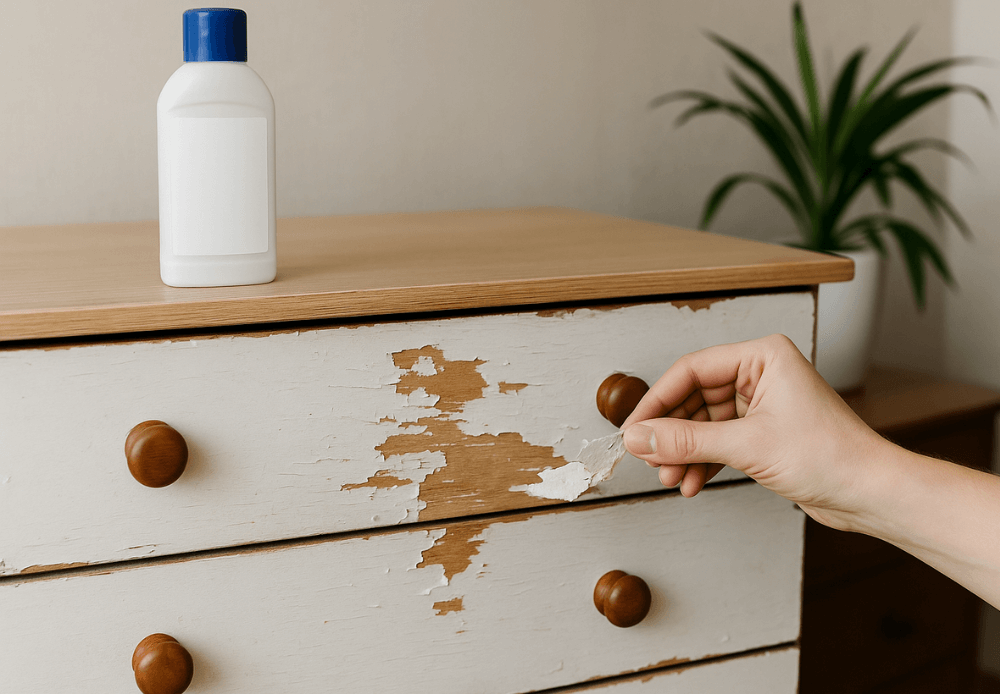Painting furniture is a great way to refresh your interior without spending a lot of money.But before you grab a paintbrush, it’s important to remember one crucial step – degreasing the furniture. The quality of the final paint finish, its durability, and how well the paint adheres to the surface all depend on how thoroughly you degrease the furniture beforehand.
Many people skip preparing the furniture for painting, thinking it’s enough to simply wipe off the dust. Unfortunately, grease, oily residues, and dirt that build up over years of use can cause even the best paint to peel or flake off quickly.
In this guide, we’ll walk you through the process step by step – showing you how to degrease furniture, which mistakes to avoid, and what degreasing products to use – both homemade solutions and professional cleaners.
Table of Contents:
- Degreasing furniture before painting – why is it important?
- What to use to degrease wood before painting?
- Degreasing products for furniture
- How to effectively remove grease from surfaces?
- How to degrease furniture? Summary and practical tips
Degreasing furniture before painting – why is it important?
Before applying the first coat of paint, it’s worth taking a moment to properly prepare the furniture’s surface. Degreasing is what determines whether the finish will be durable and visually appealing, or if the paint will start to peel, chip, or lose adhesion over time.
Surfaces – especially those that have been in kitchens, bathrooms, or used for years – often accumulate dirt, **grease**, cleaning product residues, and **oily deposits**. For paint, this creates a barrier it simply cannot overcome. Even the highest-quality product won’t adhere well if the surface hasn’t been thoroughly degreased beforehand.
The consequences of skipping this step can become visible in just a few days. Poor paint adhesion, discoloration, streaks, or peeling lacquer are just some of the issues you may face.
That’s why, if you care about a clean, long-lasting finish – it’s absolutely worth degreasing the wood. This simple step significantly increases the durability of your paint job and improves the final result, while also helping you avoid touch-ups and disappointment.

What to use to degrease wood before painting?
Before you start applying paint, you need to make sure the furniture is clean, dry, and properly prepared. Cleaning furniture before painting isn’t just about wiping off dust – it also involves removing old layers of paint and properly preparing the surface so the new paint can adhere well.
Start by carefully inspecting the wooden surfaces. Check whether the wood is damaged, cracked, or covered with remnants of old varnish or paint. If it is – you’ll need to remove the old paint or sand down the remaining layers first.
A thoroughly cleaned surface is just the beginning. The next – and most crucial – step is degreasing the wooden surface.

Degreasing Products for Furniture
Once the surface has been cleared of dust and old coatings, it’s time to degrease the furniture surface. This is a crucial step – invisible greasy stains can ruin even the best paint job. Fortunately, there are many proven ways to effectively degrease furniture – using both homemade solutions and ready-made products available in stores.
Homemade Methods for Degreasing Kitchen Furniture Before Painting
In many cases, ingredients found in your kitchen or bathroom are more than enough. Homemade degreasing methods are affordable, safe, and effective – especially for light to moderate grease and grime.
Vinegar – one of the simplest ways to degrease a surface at home. Just dilute it with water and wipe the surface with a cloth. It has natural dissolving properties and antibacterial effects. Works best on light grease and everyday dirt.
Gray soap (Castile soap) – ideal for those who want a gentle solution that won't damage wooden surfaces and still effectively removes grease. Especially useful for older furniture with delicate finishes.
Dishwashing liquid – a classic that works well for furniture, too. Add a few drops to warm water, soak a sponge, and thoroughly clean the surface. Great for surface-level buildup, though heavier grease might require a stronger agent.
Baking soda – works well for spot cleaning. Use it as a paste (mixed with water) or in combination with vinegar. If you choose to degrease furniture with baking soda, don’t forget to rinse the surface thoroughly afterward.
Each of these methods helps remove greasy contaminants and works well for preparing furniture surfaces for further refinishing. However, if you’re dealing with heavily soiled or very old pieces, professional degreasing products may be a better solution.

Professional Degreasing Products
While homemade degreasing methods are often sufficient, when dealing with old furniture that has deeply embedded greasy residues, it’s worth reaching for something stronger. Professional degreasing products offer higher effectiveness and, when used properly, won’t damage wooden surfaces.
Here are some of the most commonly used products that allow for truly effective furniture degreasing:
Solvent – has excellent dissolving properties and handles even dried-on grease. It’s one of the best choices for tough, old-fashioned grime. However, it should be used with caution – preferably outdoors or in well-ventilated spaces, and always with gloves.
Lacquer thinner – works quickly and effectively, especially where water and mild detergents fall short. Perfect for degreasing furniture surfaces that haven’t been cleaned in a long time.
Isopropyl alcohol – gentler than solvent but still very effective. It works well on dried grease stains, evaporates quickly, and leaves no streaks. Ideal for detailed work and professional surface degreasing.
Chemical cleaners for furniture – in stores, you can find dedicated wood degreasing solutions specifically designed for use before painting. They work well on furniture with complex structures, such as those with carvings or intricate details.
Ready-to-use degreasing products – a good option for those who don’t want to experiment. The label usually indicates whether it’s the right degreasing agent for a specific type of wood.
Remember: no matter which degreasing product you choose, it’s always a good idea to test it on a small, hidden area first. This helps avoid damage to the furniture surface and ensures everything goes smoothly.
How to Effectively Remove Grease from Surfaces?
Whether you choose a homemade solution or a professional degreaser, one thing matters most – precision. Effective furniture degreasing means removing greasy buildup from every corner and preparing the surface so that the paint adheres well and doesn’t peel off later.
Cleaning the Furniture Surface – First Step
Start with the basics. Wash the furniture surface with warm water and a mild detergent. Use a soft cloth or sponge to avoid scratching the wood. This step helps remove dust, light grease, and everyday dirt.
Proper Degreasing – Step by Step
Choose an appropriate degreasing agent – one that matches the type of furniture and the level of dirt.
Apply the product to the furniture surface using a sponge, cloth, or spray bottle – according to the manufacturer’s instructions.
Wipe the surface thoroughly, making sure to reach corners and detailed areas.
Wait a few minutes (if the instructions recommend it), then wipe the furniture dry.
Repeat the process if necessary.
Only when the surface is clean, dry, and free of greasy residues should you move on to priming or painting. Proper surface preparation ensures the best result – both visually and in terms of durability.

How to Degrease Furniture? Summary and Practical Tips
Degreasing furniture before painting is a step you shouldn’t skip – whether you’re restoring a flea market find or renovating solid wood furniture from your own home. This stage determines the durability of the paint job, the paint’s adhesion, and the overall final result.
If you’re wondering which degreasing products to choose, here are some practical tips:
For fresh, light dirt and grime, homemade degreasing methods like vinegar, dish soap, or baking soda are usually sufficient.
If you're dealing with stubborn grease or furniture that hasn’t been cleaned in a long time, reach for professional degreasers – such as solvent, isopropyl alcohol, or ready-to-use degreasing products.
Regardless of the method, don’t forget about proper surface preparation. This includes not only cleaning the furniture, but also drying it thoroughly and inspecting the condition of the wood.
Also make sure to use the right painting accessories – a quality brush or roller can have a real impact on the final result.
And finally, the most important point: degreasing wood is worth it. It’s a small step that makes a big difference – helping you achieve a beautiful, long-lasting finish and making the painting process truly satisfying.
Scandinavian Wooden Furniture for Your Interior
If you’d rather purchase Scandinavian-style wooden furniture, be sure to explore our collection. Choose from:

